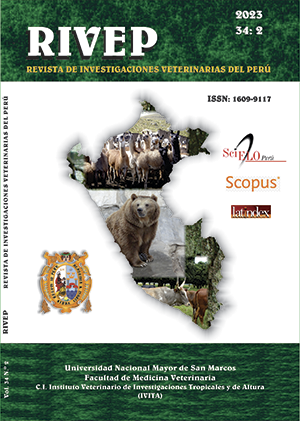Intradural-intramedullary intervertebral disc extrusion in a six-month-old Schnauzer
DOI:
https://doi.org/10.15381/rivep.v34i2.23491Keywords:
extrusion, intradural-intramedullary, tetraplegia, decreased disc volumeAbstract
Intradural-intramedullary intervertebral disc extrusion (IIVDE) is a subtype of herniation of the hydrated nucleus pulposus and occurs after extreme exercise or traumatic events. IIVDE is a rare condition, and its diagnosis can be complex since its clinical characteristics and images are poorly characterized. The case of a six-month-old Schnauzer who suffered a fall from a height of two stories is reported. The patient developed spastic tetraplegia and was diagnosed as a fourth-degree acute cervical spinal cord injury. The radiographic and computed tomography studies only reported a simple fracture in the vertebral body of C3. The magnetic resonance study reported intramedullary linear tracts, parenchymal lesions and reduced disc volume in C3-C4. The clinical condition and its evolution, as well as the imaging findings were compatible with IIVDE.
Downloads
Downloads
Published
Issue
Section
License
Copyright (c) 2023 Eben Salinas C., Otto Zea M.

This work is licensed under a Creative Commons Attribution 4.0 International License.
AUTHORS RETAIN THEIR RIGHTS:
a. Authors retain their trade mark rights and patent, and also on any process or procedure described in the article.
b. Authors retain their right to share, copy, distribute, perform and publicly communicate their article (eg, to place their article in an institutional repository or publish it in a book), with an acknowledgment of its initial publication in the Revista de Investigaciones Veterinarias del Perú (RIVEP).
c. Authors retain theirs right to make a subsequent publication of their work, to use the article or any part thereof (eg a compilation of his papers, lecture notes, thesis, or a book), always indicating the source of publication (the originator of the work, journal, volume, number and date).










